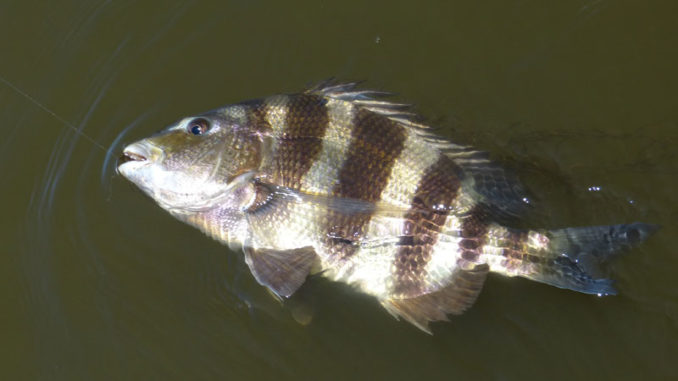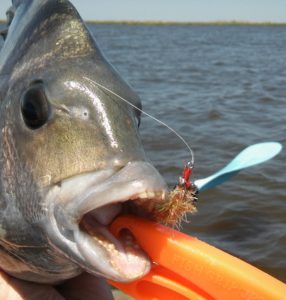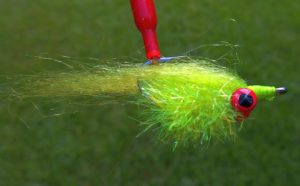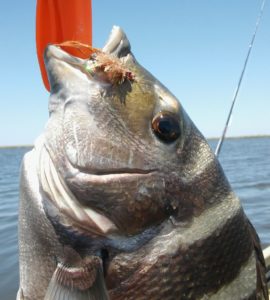
Back in April, at the annual “Fly Fishin For the Mission” tournament, my partner Kevin “Doc” Andry and I were looking to repeat as the top kayak fishing team for the third year in a row.
Sometime around 10 a.m., things were looking very promising for a repeat performance. Doc and I had each landed a couple decent slot reds, and the tide was just getting right for the big fish to move onto the banks.
That’s when things took a turn. Actually, I took a turn – down a deep dark hole of obsession!
I spotted this large grass flat full of sheepshead. Sheepies remind me of the Hypnotoad on the cartoon comedy “Futurama.” Spot one, and they hypnotize you into casting to them.
Most of the time it’s a trap. They have no intention of eating your fly. It’s a conspiracy to make you forget about the redfish.
Well, I have to say it worked – somewhat. I forgot about the reds and spent the next three hours trying to catch those toothy convicts. But it didn’t go exactly the way they had hoped.
The Cajun Permit
Throughout the northern Gulf Coast, sheepshead are highly revered among fly anglers. They’ve been branded the “Cajun Permit” because much like their tropical-waters namesake, they are extremely wily and difficult to get a solid bite.

The key to catching sheepies – especially the big ones which we call “goats” – is patience. That, and the right fly, the right presentation, and lots of luck!
If the goats are rooting in the bottom, with their tails waving out the water, it’s worth a cast. But don’t expect much. These fish seldom track a fly.
Spot a small pod that’s moving across a grass flat, and you’re in much better luck. You need to cast several feet ahead to avoid spooking them. Then hold off your retrieve until the fish get close.
Good time Charlie
I’ve caught sheepshead on a wide variety of flies – even a couple on poppers! But by far, the largest number have come on Charlies. It’s always a good time when you have these flies at the end of your leader!
The original Crazy Charlie was developed in 1977 by Charlie Smith, a bonefish guide out of Andros Island in the Bahamas.
Numerous variations of this fly have been created. The most recognized is Bob Nauheim’s “Pink Charlie.” Despite the name, this version can be any color. It has a kip tail wing, bead-chain eyes, and a clear monofilament body.
A few versions are credited to Louisiana-based fly tiers. The Disco Charlie was originated by Dave Diaz, a former resident of Metairie. It has a marabou wing and a metallic braid body. The Cactus Charlie, originated by Kyle Moppert of Baton Rouge, uses a cactus chenille body.
All of the above-mentioned variations are very effective for reds and drum. But when it comes to sheepshead, there’s one that outshines them all – literally.
Special sauce
When my good friend Mike LaFleur created his variation of the Charlie some 25 years ago, he asked me to critique it using my standard pool testing.
The LaFleur’s Charlie is tied on a Mustad 34007 hook (or equivalent) with lead eyes. The body is estaz material wrapped from the bend of the hook to just behind the eyes. Then a wing of craft fur is tied in just in front of the eyes.

In testing, the fly had a sharp angle of downward attack. Yet the wide-body estaz kept it from sinking too fast. It was absolutely perfect in that regard.
What struck me was the craft fur. Not only did it undulate in the water, but it glistened. If you pick up a shrimp or small crab and look it over, you’ll see their exoskeletons have a great deal of glimmer and sparkle.
Mike told me this was a special type of craft fur. Sometimes called “Fun Fur,” it has a high modacrylic content. It’s the “special sauce” to this fly.
The traditional pink works well, but equally effective colors are purple, tan and black.
The best presentation is to let sink a couple seconds, then strip slowly about 6 to 8 inches. Most hits come midway during the strip.
Goat paradise
It was now late morning on tournament day, and I was now deeply committed to catching a sheepshead on the fly.
The grass flat I’d encountered was full of small pods of goats. They were swimming slowly in aimless circles, perhaps looking for shrimp or crabs to pop out from the grass.
After 15 minutes of fruitless efforts using a crab pattern, I tied on a size 2 tan LaFleur’s Charlie.
I placed the cast about five feet ahead of a moving pod. I didn’t have to wait to strip – one skirted forward and ate the fly on the fall.
Two hours later – with 10 sheeps hooked and eight landed – I was ready to paddle back to the launch. Goat paradise had given me plenty of anxious fish to cast to. Having the right fly and the right presentation paid off.
My heaviest entry came in at 5.6 pounds, enough to win the Sheepshead Division.

In addition, this tied my personal best ever for number of sheepshead on fly in a single day.
The only time I caught this many on fly rod, the fly du jour was also a LaFleur’s Charlie. Now you know why, when it comes to goats, this fly is the GOAT (Greatest Of All Time).
Louisiana fly anglers recognized
In July, at the Fly Fishers International annual expo in Bozeman, Montana, two Louisiana residents were recognized.
Keith Richard of Breaux Bridge was recognized with the 2019 Jay Gammel Award for “his lasting contributions to the teaching of fly casting instruction.”
Richard, an FFI Master Certified Casting Instructor, has conducted numerous workshops on fly casting. He teaches and tests candidates for casting certification, and authored articles on the subject. He is owner of The Camp Fly Fishing School and works with AHERO in promoting fly fishing for veterans.

Jeff Ferguson of Lake Charles was awarded the 2019 Council of Excellence Award. The COE Award is presented annually to an individual who has made outstanding contributions to fly fishing at a regional level.
Ferguson, also an FFI Master Certified Casting Instructor, participated in several casting instruction workshops across the country and hosted a nationwide casting program in Lake Charles. He also assisted several regional clubs and events with their casting programs.
Fishing forecast
September is “back to school” time for bass, crappie, reds and jacks.
Look for bass busting shad in the morning on lakes and ponds. Crease Flies, Clouser Minnows, Threadfin Fly, Coma Cocahoes, and weighted Deceivers in white or tan will work.
After the first couple of nights with temperatures below 60 degrees, sac-a-lait will congregate in shallow water along structure. Cast a Fluff Butt or Crappie Candy up close and retrieve slowly. Or use a small strike indicator to suspend the fly, and watch for any tick in the indicator.
Big redear sunfish come out of their doldrums this month and will feed on shell flats and sandy shoals. The Rosborough Hares Ear, Cap Spider, and any other “lively” sinking fly will produce mighty chinquapins!
In Orleans and Jefferson parishes, the rios make their final spawning rituals this month. These cichlids love wet flies, woolybuggers, and popping bugs. Catching one of the larger “brainiacs” on an ultralight rod should be on every fly angler’s bucket list!
Extremely high tides this month will hinder some sightcasting to reds in ponds, but that’s not where you want to be anyway. The open waters hold bull reds and jack crevalle. Bring your 10-weight and lots of baitfish patterns and hope your arms don’t wear out!
What’s happening
- Sept. 8 (Sun) – Fly Fishing FUNdamentals, hosted by Pack & Paddle, 601 E. Pinhook, Lafayette. 2 p.m. Cost $40. One-day clinic covering basics of fly fishing, along with hands-on fly casting instruction. Seats limited, so pre-registration required. For details, go to www.packpaddle.com.
- Sept. 25 (Wed) – Bonefish & Tarpon Trust Cocktail Evening, hosted by Orvis of Baton Rouge, 7601 Bluebonnet, Baton Rouge. 5 p.m. Meet BTT staff and scientists and learn about their efforts, including tarpon tracking in Louisiana. Pre-registration required. For more info, call 225-757-7286.
- Sept. 28 (Sat) – National Hunting and Fishing Day. Hosted by Louisiana Department of Wildlife and Fisheries, with venues at Baton Rouge, Minden, Monroe, Woodworth. Free admission. Exhibitors, activities and more for the entire family. Baton Rouge, Woodworth, and Minden venues will have hands-on fly casting and fly tying. For details, go to www.state.ldwf.us.
- Oct. 5 (Sat) – 11th annual Rio Grande Rodeo, hosted by New Orleans Fly Fishers club. Open to the public, entry fee $10. Sign in 7:30 a.m., fishing time 8 a.m. to Noon (weigh-in). Fly fishing only. Categories include Largest Rio and Most Rios. For more info, go to www.neworleansflyfishers.com.